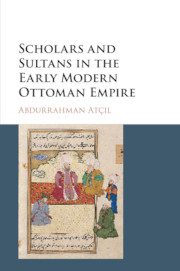Book contents
- Frontmatter
- Dedication
- Contents
- List of Tables
- Notes on Usage
- Acknowledgments
- Introduction
- Part I Scholars during the Early Ottoman Period (1300–1453)
- Part II The Formation of the Hierarchy (1453–1530)
- 3 Introducing the Ottoman Empire
- 4 Scholars in Mehmed II's Nascent Imperial Bureaucracy (1453–1481)
- 5 Scholar-Bureaucrats Realize Their Power (1481–1530)
- Part III The Consolidation of the Hierarchy (1530–1600)
- Conclusion
- Glossary
- Bibliography
- Index
4 - Scholars in Mehmed II's Nascent Imperial Bureaucracy (1453–1481)
from Part II - The Formation of the Hierarchy (1453–1530)
Published online by Cambridge University Press: 24 November 2016
- Frontmatter
- Dedication
- Contents
- List of Tables
- Notes on Usage
- Acknowledgments
- Introduction
- Part I Scholars during the Early Ottoman Period (1300–1453)
- Part II The Formation of the Hierarchy (1453–1530)
- 3 Introducing the Ottoman Empire
- 4 Scholars in Mehmed II's Nascent Imperial Bureaucracy (1453–1481)
- 5 Scholar-Bureaucrats Realize Their Power (1481–1530)
- Part III The Consolidation of the Hierarchy (1530–1600)
- Conclusion
- Glossary
- Bibliography
- Index
Summary
The period 1453–81 (from the capture of Istanbul until Mehmed II's death) proved to be the beginning of a new phase in the Ottoman government's relationship with scholars. Flushed with the prestige of capturing Constantinople, Mehmed II initiated an imperial program and undertook grandiose architectural and legal projects. His unprecedentedly large investments in madrasas attracted many scholars to move to the empire. In addition, he designed and implemented a hierarchical framework that not only provided scholars with a lifetime career in the administration, but also created career expectations and caused an ever-increasing number of them to offer their services to the dynasty. In this chapter, I discuss the efforts of Mehmed II and his men to establish Istanbul as the imperial center, project himself as a patron of scholars and artists, and create a civil bureaucratic class of scholar-bureaucrats based on the appropriate institutional and legal frameworks. I show how the internal and external conditions, as well as deliberate policies, of those years enabled the dynasty to start developing a bureaucratic structure. In addition, I draw attention to the fact that while this envisaged institutional framework was developing, certain features of the early Ottoman period (for instance, personal ties between the sultan and scholars and the scholars’ reluctance to wholeheartedly dedicate themselves to the Ottoman project) still existed.
Rebuilding Istanbul and Supporting Scholars
A significant component of the imperial program was architectural. Building mosques, madrasas, public bathhouses, marketplaces, and other establishments and converting Byzantine buildings to new purposes projected the sultan's imperial vision on Istanbul and other cities in stone. Another component was to increase the importance of Ottoman cities, especially Istanbul, as centers of learning. To this end, Mehmed II and his men erected madrasas in Istanbul and elsewhere.
It seems that Istanbul's reconstruction was central to creating a hierarchical institutional framework through which scholars could affiliate themselves with the dynasty and its enterprise. I contend that controlling the planning and completion process of architectural projects in Istanbul, especially madrasas, enabled Mehmed II to project a hierarchy of madrasas and impose a hierarchical structure on the scholars.
Eager to repopulate his capital city, Mehmed II forced people to migrate to it; others came willingly. The commercial center was rebuilt to propel economic development. These policies succeeded, and the population grew from about 10,000 in 1453 to more than 50,000 in 1478.
- Type
- Chapter
- Information
- Scholars and Sultans in the Early Modern Ottoman Empire , pp. 59 - 82Publisher: Cambridge University PressPrint publication year: 2016

